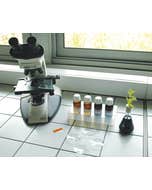Kit to visualize the conducting systems of a plant: xylem and phloem
Topics covered:
- Showing that there are two distinct systems responsible for sap conduction within a stem
- Learning to use an optical microscope
Activity 1: This involves showing that there are structures responsible for sap conduction within a stem (soaking for 24 hours in methylene blue). A thin section of the stem observed under the microscope highlights a tissue colored by methylene blue, specialized in conduction: the conducting vessels.
Activity 2: Now the aim is to show that there are two distinct sap conduction systems within a stem. Follow the steps of the double staining protocol (alum carmine and brilliant green). There are two types of sap with distinct compositions, suggesting that they circulate in separate systems within the plant, the xylem (in blue-green) and the phloem (in pink).
Composition:
4 bottles of 60 ml of reagents (brilliant green, alum carmine, sodium hypochlorite, ethanoic acid), 4 dropper pipettes, 1 rack.
Additional materials needed: Safety blade (ref. 564064), microscope slides (ref. 573013), coverslips (ref. 573015), elderberry pith (ref. 573018), 60 mm glass watch glasses (pack of 10 - ref. 713066), microscope
Comments:
Mint is an interesting plant because it is known to students and available all year round. Double staining gives very good results on other plants (tarragon, celery). Prefer separate solutions of alum carmine and brilliant green rather than a mixture of the two which gives poorer results.
| Thématique TP | Biologie |









